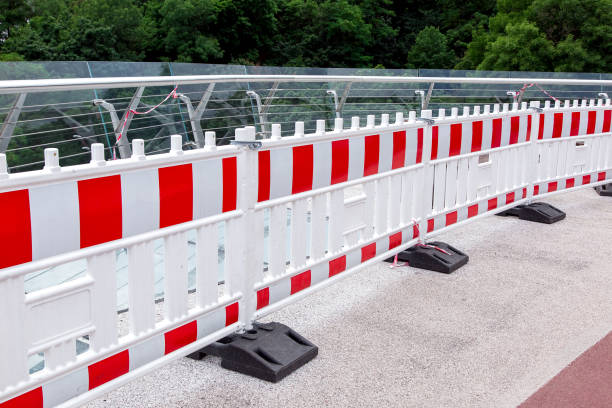Managing crowds in high-traffic areas is like trying to direct the flow of a river—you need barriers and guidance to ensure everything moves smoothly without chaos.
Whether it’s a busy urban street, a packed concert venue, or a bustling festival, crowd control barriers play a pivotal role in ensuring safety and keeping things organized. But it’s not just about putting up barriers wherever you think they’ll fit; there’s an art (and science) to effective crowd management.
In this guide, we’ll break down some of the best practices for using crowd control barriers in high-traffic areas, ensuring a smooth flow of people and keeping safety at the forefront.
Why Are Crowd Control Barriers Important?
Before diving into best practices, it’s crucial to understand the purpose of crowd control barriers. They’re not just there to keep people out of certain areas—they serve a range of functions:
- Directing Flow: Barriers help manage foot traffic and guide people in the right direction.
- Maintaining Order: Prevent overcrowding in specific areas and avoid chaotic bottlenecks.
- Enhancing Safety: Protect attendees by creating safe zones and preventing access to hazardous areas.
- Creating Boundaries: Clearly define VIP zones, restricted areas, or emergency exits.
With these goals in mind, let’s explore how to effectively use crowd control barriers in high-traffic areas.
1. Plan Ahead: Understand the Flow of People
Crowd control starts long before the barriers are set up. You need to understand how people will move through the space. Picture it: where will people enter? Where will they leave? Are there pinch points where crowds could build up? Think about the busiest areas and how you can reduce congestion.
Example:
At a large music festival, you’ll likely have multiple entry and exit points, food stalls, and performance stages. Mapping out how people will navigate between these areas helps you figure out where barriers will be most effective.
Key Tip:
- Use barriers to direct the flow, not block it. They should act as gentle nudges, guiding people toward where they need to go.
2. Use Barriers to Create Clear Pathways
In a high-traffic area, people need to know where to go without having to think too hard about it. Barriers can create obvious walkways, making it easier for people to move from point A to point B.
Example:
In airports, for instance, barriers guide passengers through security checks and to their gates. Imagine if those barriers weren’t there—it would be total chaos! Barriers make sure that people are walking in the right direction, preventing confusion and crowding.
Key Tip:
- Avoid making the pathways too narrow. Narrow paths can quickly become congested, causing frustration and bottlenecks.
3. Strategically Place Barriers to Prevent Overcrowding
One of the biggest dangers in . Placing barriers in the right spots can prevent too many people from gathering in one place at the same time. This is especially crucial in places like concerts or sporting events, where emotions run high and crowds can become unpredictable.
Example:
At a stadium, barriers are used to keep fans from rushing the field, but they’re also placed around seating sections to keep movement smooth and organized. This ensures that even if large numbers of people are moving, the flow remains steady and safe.
Key Tip:
- Consider flexible barriers for areas that may need to adjust based on crowd size. Movable barriers allow you to expand or reduce sections as needed.
4. Ensure Accessibility and Emergency Access
While it’s important to guide the flow of people, you also need to make sure that accessible routes are available for those with disabilities and that there are clear paths for emergency responders. Barriers should never block these essential routes.
Example:
At a parade, barriers may line the streets, but there should always be breaks to allow emergency vehicles or first responders quick access in case of an incident. Similarly, ensure that your barriers don’t restrict wheelchair access.
Key Tip:
- Always leave gaps for emergency exits and accessible routes. Use signage to clearly mark these areas so that everyone is aware of them.
5. Consider the Aesthetics and Functionality
Let’s face it: crowd control barriers aren’t always the most attractive things. If you’re hosting a high-end event, consider how the barriers will affect the overall look and feel of the space. However, don’t sacrifice safety for aesthetics. The good news is that there are modern, aesthetically pleasing options available that still get the job done.
Example:
For events like weddings or high-end parties, rope and stanchion systems offer an elegant look while still maintaining crowd control. Alternatively, decorative planters can serve as natural barriers that blend into the environment.
Key Tip:
- Choose the right type of barrier for the type of event. A sturdy metal barrier might be necessary for a rowdy concert, but it could be overkill for a small, upscale gathering.
6. Regularly Inspect and Adjust Barriers During the Event
Even the best-laid plans can change in the heat of the moment. As your event unfolds, you’ll need to monitor the flow of people and adjust barriers as necessary. This ensures that any unforeseen issues—like an unexpected surge in attendees—can be managed effectively.
Example:
At a busy street festival, you might notice that a food stall is drawing bigger crowds than anticipated, leading to a bottleneck. Adjusting the barriers to give people more space to queue can help ease the flow and prevent accidents.
Key Tip:
- Assign staff to regularly check the barrier placement and make adjustments on the fly if necessary.
7. Use Signage Alongside Barriers
Barriers on their own can guide people, but they work even better when combined with clear signage. Signs help people know exactly where they’re supposed to go, reducing confusion and ensuring the crowd flows smoothly.
Example:
At a convention, you’ll often see signs above the crowd control barriers directing people to specific areas, such as restrooms, entrances, and exits. This combination of barriers and signs keeps everyone moving in the right direction without asking too many questions.
Key Tip:
- Pair barriers with directional signage to give people the information they need at a glance.
Conclusion
Crowd control barriers are more than just a tool for keeping people in line—they’re essential for maintaining safety, order, and a smooth flow of people in high-traffic areas. By planning ahead, placing barriers strategically, and monitoring the crowd throughout the event, you can ensure that everyone enjoys a safe and seamless experience.
Whether it’s a music festival, parade, or corporate event, following these best practices will help you strike the perfect balance between crowd control and attendee comfort.
FAQs
1. What’s the most common mistake when setting up crowd control barriers?
One of the most common mistakes is failing to plan the crowd flow ahead of time, which can lead to bottlenecks or overcrowded areas.
2. How do I ensure accessibility with crowd control barriers?
Always leave gaps for accessible routes, such as for wheelchairs, and make sure these routes are clearly marked.
3. Are there eco-friendly crowd control options?
Yes, many events now use planters or recycled materials for barriers, combining functionality with environmental friendliness.
4. How often should I check the barriers during an event?
It’s a good idea to have staff monitor the flow of people and inspect the barriers regularly to adjust for any unexpected crowd surges.
5. Can barriers be customized for my event’s aesthetics?
Yes, barriers can be dressed up with banners, lighting, or decorative elements to blend in with your event’s theme while still maintaining safety.



